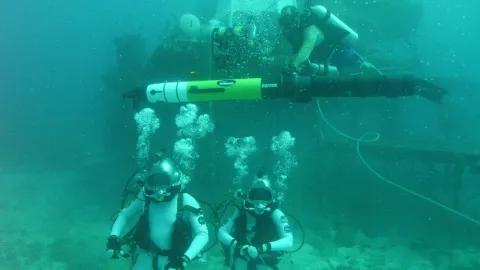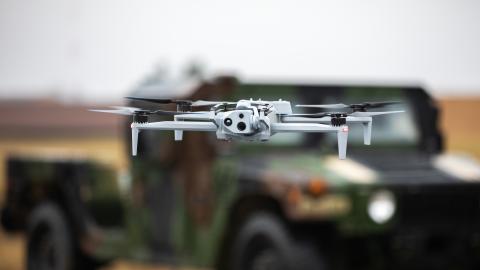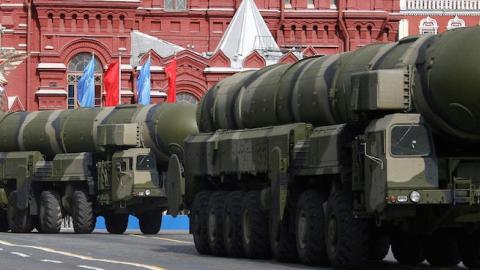Although attention is naturally focused on the role of Russia’s conventional forces in the Ukraine conflict, we should not overlook the modernization of the country’s nuclear forces. The last few years has seen Moscow make great progress in stabilizing Russia’s decaying nuclear arsenal. The Russian government considers its nuclear weapons as its best tool of defense, deterrence, and global influence-- essential for protecting Russia against external aggression and for preserving its great power status. Despite recent improvements in Russia’s conventional forces and Russian mastery of the art of non-kinetic hybrid warfare techniques, Moscow continues to invest enormous sums in reviving its nuclear capabilities, which suffered financial and other problems following the end of the Cold War. Nonetheless, Russia’s nuclear buildup will continue to face major challenges in coming years and present risks to other countries.
Systems
In determining their nuclear arsenal, Russian policy makers employ an expansive force-sizing principle, in which Russian nuclear forces must be able to counter the combined arsenal of all other nuclear weapons states . Due to this demanding mission and the weight of the Soviet legacy, the structure and composition of Russia’s current nuclear forces strongly resemble the force that it inherited at the end of the Cold War. Russia continues to maintain a strategic triad of land-based intercontinental ballistic missiles (ICBMs), strategic submarines (SSBN) with long-range sea-launched ballistic missiles (SLBMs), and long-range bombers equipped with short-range nuclear-armed missiles and gravity bombs. Many of these have multiple independently targetable re-entry vehicles (MIRVs) for carrying more than one warhead as well as decoys and other penetration aids. Russia has also retained many smaller tactical nuclear weapons that it inherited from the Soviet period and is developing its own strategic defenses even as it criticizes U.S. missile defenses as destabilizing.
The ICBMs of Russia’s Strategic Missile Forces (SMF) have historically represented the mainstay of the country’s strategic deterrent. Russia’s more than three hundred ICBMs can carry approximately 1,000 warheads. Since Russia’s operational ICBMs are on average 30-40 years old, many have reached the end of their service lives and are being decommissioned. Moscow is currently in the process of retiring all of its Soviet-era ICBMs (the SS-18, the SS-19, and the single warhead SS-25) and replacing them with systems built and increasingly designed in the years following the Cold War, such as the Topol-M (SS-27) and the multi-warhead RS-24 Yars. At present, the SMF fleet is split roughly equally between the two generations, but in another decade all of Russia’s strategic missiles will be post-Soviet. Russia is expected to begin production soon of a new 100-ton ICBM, known as Sarmat, to replace the SS-18. Like the SS-18, the Sarmat will be a heavy ICBM using liquid fuel, based in hardened fixed silos, and capable of carrying ten MIRVs.
The future of Russia’s sea-based nuclear deterrent rests with the fourth-generation Project Mk 955 Borey-class nuclear-powered SSBN and its new RSM-56 Bulava SLBM, a combination designed as the foundation of Russia’s maritime nuclear triad through at least the 2040s. The first two Borey-class SSBNs, the Yuri Dolgoruky and the Aleksandr Nevsky, joined the fleet last year. However, their entry, and those of the other six planned Bereys, has been repeatedly delayed due to problems with the Bulava missile. About half of the missile’s 19 test launches have failed, sometimes spectacularly. After an overhaul of the missile’s production process in 2009, the flight test program had a pair of successful launches in 2010–2011, leading to a decision to put it into serial production. However, the Bulava failed its 20th flight test in September 2013, reawakening doubts about the system’s reliability and delaying the entry of further Borey-class submarines into the fleet. Russia now plans to resume testing of the Bulava missile in late 2014. The new Borey strategic submarines are desperately needed to replace the current fleet of three Project 667BDR Kalmar (NATO: Delta III) and six Project 667BDRM Delfin (NATO: Delta IV ) strategic submarines. The Navy is preparing to decommission the Delta IIIs, while modernizing the Delta IVs, to extend their service lives for another 10-15 years.
Russia’s strategic bomber fleet remains the weakest leg of its offensive strategic triad. It consists almost exclusively of Soviet-manufactured platforms capable of launching long-range air-launched cruise missiles (ALCMs) armed with nuclear warheads. The Long-range Aviation Command has 55 turboprop Tu-95MS (NATO-designated “Bear”) heavy bombers built in the 1950s and 11 swing-wing supersonic jet Tu-160 “Blackjack” bombers, nicknamed “White Swans” by their pilots. The Blackjacks are being modernized to extend their service lives. For example, they are receiving NK-32 engines, which will last longer than their original engines. The upgrades will also enable the planes to use gravity bombs as well as conventionally armed cruise missiles. The Russian government also plans to build a new strategic bomber before the end of this decade. This new bomber, codenamed PAK DA, will likely carry a new long-range nuclear-armed cruise missile, the Kh-102, which is currently under development. Like its U.S. counterparts, the future bomber will probably also have the capacity to conduct non-nuclear strikes with several types of conventional weapons.
Challenges
Although Russia has more than enough nuclear warheads and constituent components, it has nevertheless encountered problems deploying adequate numbers of strategic delivery platforms. Since the breakup of the Soviet Union, Russian defense enterprises have manufactured considerably fewer strategic ballistic missiles than required to replace the country’s aging land- and sea-based strategic deterrents. As a result, the mass decommissioning of Soviet-era ICBMs (with as many as ten warheads each) and their replacement by only a small number of single-warhead ICBMs, has resulted in a precipitous decline in the relative contribution of Russia’s land-based missiles to the offensive strategic triad, at least measured in terms of warheads.
One way Russia is trying to compensate for the diminished size of its ICBM fleet is to improve the other two legs of its strategic nuclear triad. In particular, the Russian government has devoted vast resources to revitalizing the sea-based leg of its nuclear deterrent, lavishing attention on the Borey-Bulava combination. For political and military leaders who have traditionally relied on land-based ICBMs for most of their country’s strategic nuclear warheads, however, Russia’s growing dependence on its more vulnerable submarines and bombers must arouse a certain degree of anxiety.
Moscow is trying to counter this trend by increasing the number of warheads it places on each remaining ICBM. The plans to rebuild the land-based ICBM fleet by deploying more MIRV-ed systems should help limit the speed with which the number of warheads on Russia’s ICBMs fall, but at the cost of crisis stability. Placing more warheads on a fewer number of strategic systems increases the incentives for its adversaries to strike first in any crisis with the objective of destroying Russia’s limited number of MIRV-ed systems before they have launched and released their individual warheads, which exponentially increases the number of targets the defender needs to destroy. Russia also has a strong incentive to launch its MIRV-ed missiles in a crisis rather than risk losing such a concentrated target of warheads to a U.S. first strike.
To cut costs and facilitate maintenance and training, the Russian military is seeking to reduce the types of delivery systems it has in each leg of the offensive triad. Instead of half a dozen ICBMs and SLBMs, the military is developing and producing a pair of each delivery systems. But the decision to reduce the variety of nuclear delivery platforms in service has already created crises whenever one type has experienced production (e.g., the Topol-M) or development (e.g., the Bulava) problems. The reduction in the types of nuclear warheads creates comparable risks from the failure of a particular warhead design.
Russia’s smaller number of ICBMs would also make it easier for a strategic defense system to target and destroy them. Russian missile designers have tried to make their systems less vulnerable to BMD systems by making their launchers mobile (so that their launch location and flight path is less predictable); having the missiles cut or drop their engines as soon as possible to reduce their infrared signature; giving missiles auxiliary engines or using maneuverable warheads, which are much harder to intercept than those flying a simple ballistic trajectory; applying stealth coatings to warheads that reduce their heat and electromagnetic signature to sensors; and making the decoys’ flight path in outer space closely resemble those of their warheads. Nevertheless, the capabilities, efficacy, and availability of these new technologies and tactics remain uncertain.
Through its enormous spending to modernize Russia’s nuclear forces, the Putin administration looks likely to stabilize the size of the force in coming years as well as replace its Soviet-era weapons systems. Nevertheless, the weakening Russian economy and the government’s plans to spend more on conventional forces by, for example, buying more expensive precision-guided munitions for the army and air force, could further reduce the resources available for modernizing Russia’s nuclear arsenal. The Russian government appears prepared to rebalance its funding in coming years and devote more resources on conventional forces and other priorities. The Kremlin is reluctant to cut social spending in such a volatile political situation, even to boost defense spending, and now needs to devote enormous funds to integrating Crimea into the Russian Federation. The sanctions the Western governments imposed on Russia for its aggression in Ukraine are hurting its overall growth prospects and could disrupt Moscow’s nuclear modernization since factories in Ukraine were key components of the Soviet military-industrial complex.















